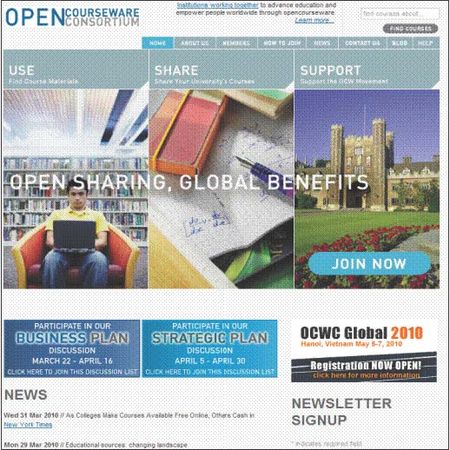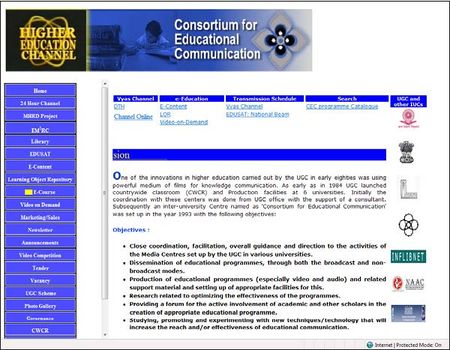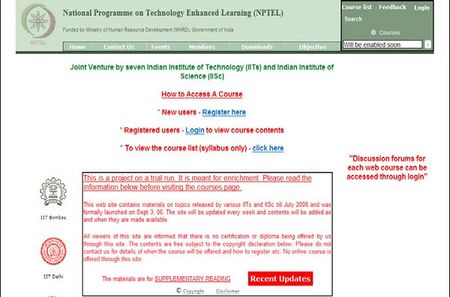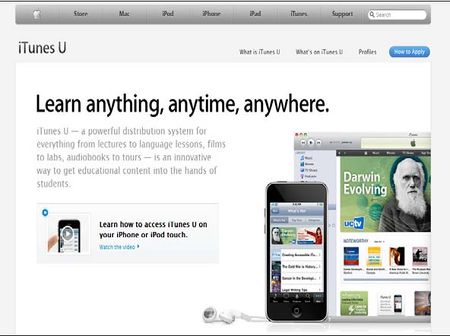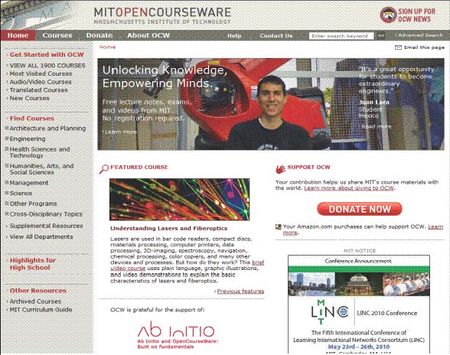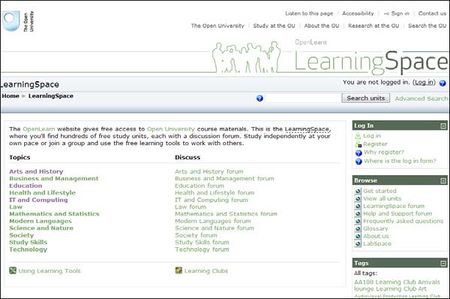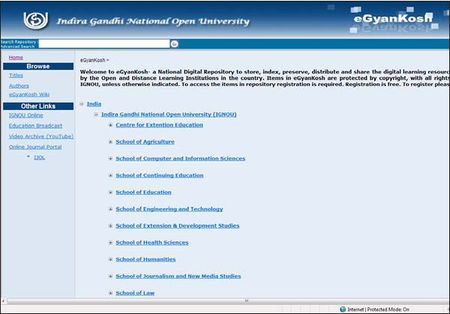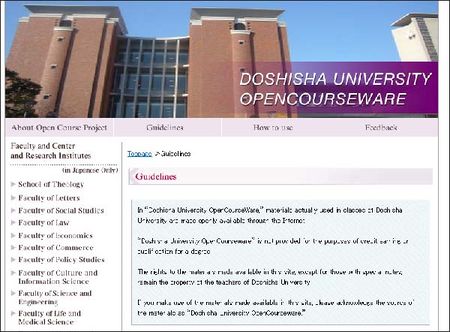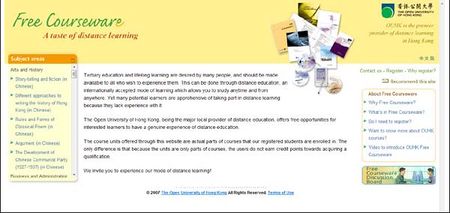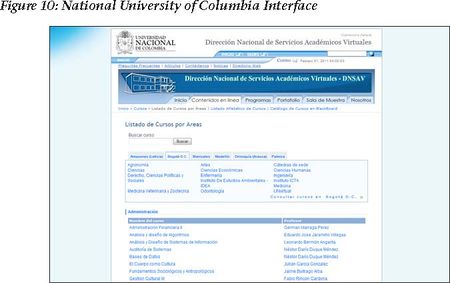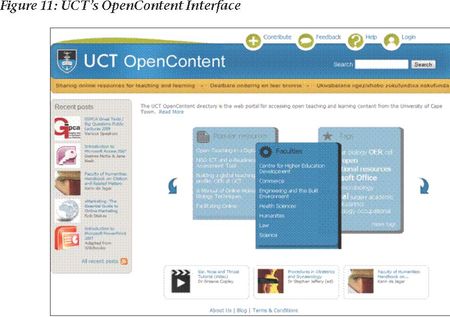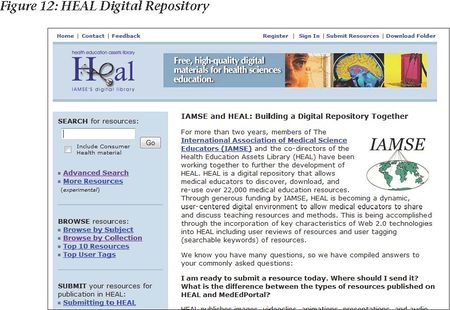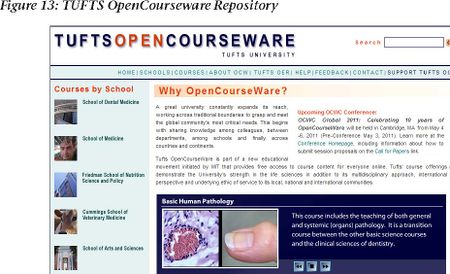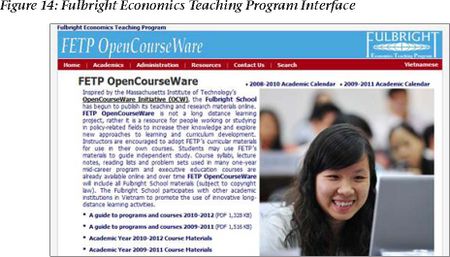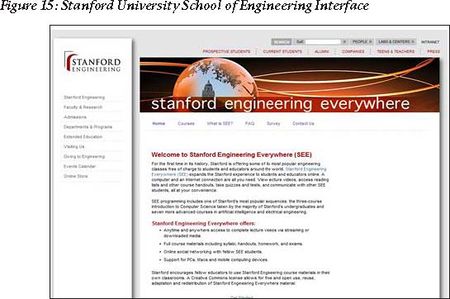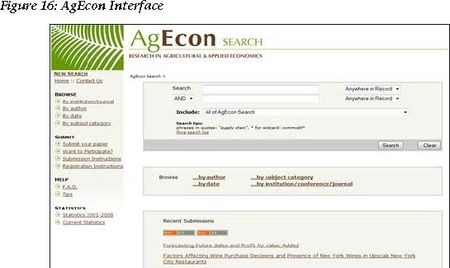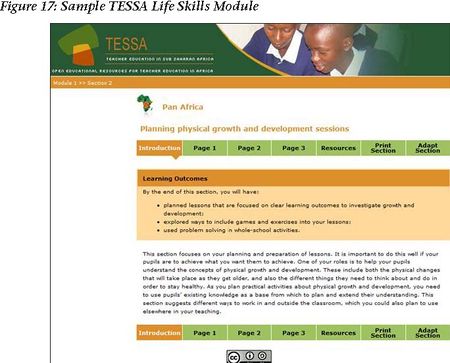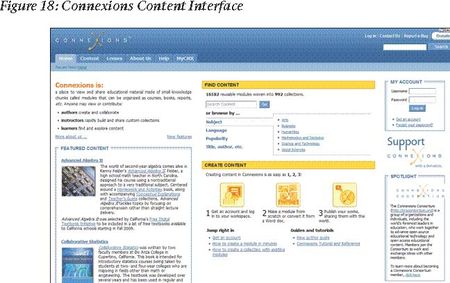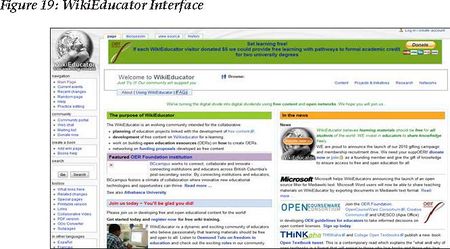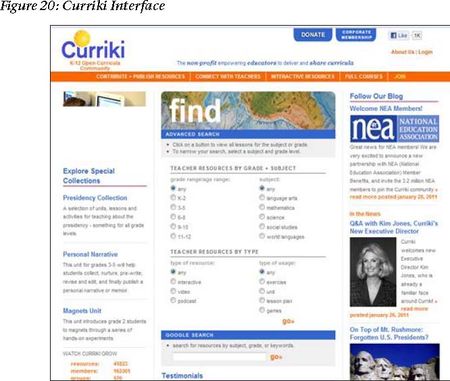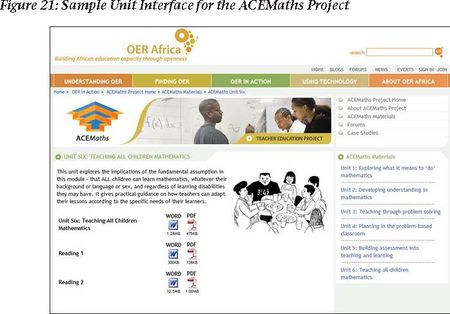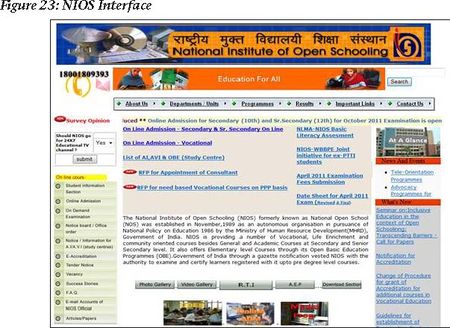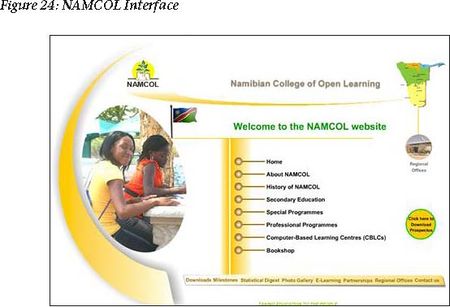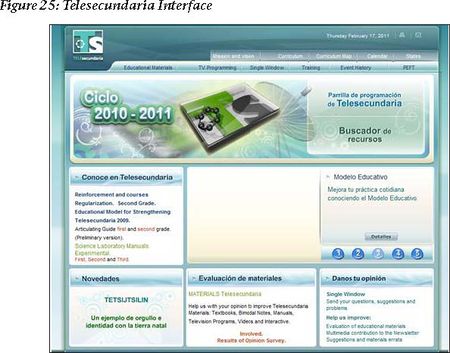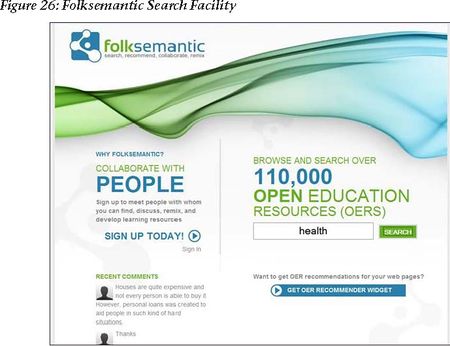A Basic Guide for OER/Appendix 5: Mapping the OER Terrain Online
Contents
Appendix Five: Mapping the OER Terrain Online
Introduction
This appendix provides an illustrative description of different kinds of facilities and services available online that are linked to Open Educational Resources (OER) in some form. The analysis is organized according to the following categories:
- Open Courseware (OCW) OER Repositories;
- University OCW Initiatives;
- Content Creation Initiatives;
- Subject-Specific OCW OER;
- Open Schooling Initiatives
- OCW OER Search.
Although the descriptions do not seek to be comprehensive, they provide a good snapshot view of what is available in each category. The appendix is supplemented by a more comprehensive catalogue of online facilities and services presented in Appendix Five.
OCW OER Repositories
Much work on OER in higher education has taken place in the United States of America (USA), but practices are growing rapidly internationally. One of the major approaches to promoting OER globally is through OpenCourseWare (OCW), where the focus is on developing and sharing freely available, stand-alone, online course, and teaching materials. OCW usually includes items such as lecture notes, reading lists, course assignments, syllabi, study materials, tests, samples and simulations. Much work in this regard has been done by the OpenCourseWare Consortium (www.ocwconsortium.org):
The OpenCourseWare Consortium is a collaboration of more than 200 higher education institutions and associated organizations from aroundthe world creating a broad and deep body of open educational contentusing a shared model. The mission of the OpenCourseWare Consortium is to advance education and empower people worldwide through opencourseware.21
Figure 1: OCWC Interface
The consortium has members across the globe, from countries as varied as Saudi Arabia, Spain, Taiwan, China, France, India, Mexico, Portugal, and Japan.22 Materials are available in several languages, including Chinese, Dutch, and Spanish, although most are in English. There are currently over 2,500 open courses available from over 200 universities. Users can find course materials by browsing individual university OpenCourseWare websites or by searching across all courses in the OCW Consortium’s website.
Similarly, the Multimedia Educational Resource for Learning and Teaching Online (MERLOT) provides free and open resources designed primarily for faculty and students of higher education (www.merlot.org). MERLOT allows users to find peer reviewed online teaching and learning materials, and share advice and expertise about education with expert colleagues. The site is organized by discipline and anyone can use it for free. At the moment, it has more than 22,500 resources.
As indicated above, there is growing interest in and development of OER initiatives in other parts of the world. For example, in China, 451 courses have been made available by 176 university members of the China Open Resources for Education (CORE) consortium. CORE is also involved in translating these courses into English as part of its Chinese Quality Open Courseware (CQOCW) project (see http://ocw.core.org.cn/CORE).
In Japan 1,500 courses have been made available by universities participating in the Japanese OCW Consortium (www.jocw.jp) of which 1,285 are in Japanese and 212 are in English. In France, over 2,000 educational resources from around 200 teaching units have been made available by twelve member universities of the ParisTech OCW project (www.paristech.fr/en)
There are also similar HE OER initiatives based in the United Kingdom (UK). One such example is JORUM (www.jorum.ac.uk), which is a free online repository service for teaching and support staff in UK Further and Higher Education Institutions. The JorumOpen collection contains a variety of resources, including OER that are freely available to all. The focus is on helping to build a community for the sharing, reuse and repurposing of learning and teaching materials.
There are also projects underway to make OCW materials available in multiple languages, including Universia’s Spanish and Portuguese translations (http:// ocw.universia.net/en). This site contains Spanish and Portuguese OCW from over 90 participating institutions. CORE is also involved in providing simplified Chinese translations. In addition, some OCW institutions such as John Hopkins Bloomberg School of Public Health are using Opensource Opencourseware Prototype System (OOPS), a program that translates educational resources into Chinese. OOPS has replicated the School’s OCW site in simplified Chinese and in traditional Chinese.
In India, a number of institutions are also digitizing their course materials and a good number of open courseware have been established.
The Consortium for Educational Communication (CEC) is an inter-university centre on electronic media, established by the University Grants Commission (UGC). CEC’s Learning Object Repository (LOR) houses educational resources in different subjects such as Archaeology, Biology, Botany, Chemistry, Commerce, Computer Science, Economics, Education, English and Fine Arts.
Figure 2: CEC LOR Interface
The National Programme on Technology Enhanced Learning (NPTEL) aims to enhance the quality of engineering education in India by developing curriculum based video and web courses. This is being carried out by seven premier institutions as a collaborative project. Currently samples from approximately 70 courses offered by faculty in various departments and to students at all levels (B.Tech, M.Tech, M.S., M.Sc., Ph.D.) are available. Approximately 140 courses are in various stages of preparation and distribution.
Figure 3: NPTEL Interface
In addition to courses, the number of available non-course OER such as articles, Open Access Journals and books are also growing at a fast rate. For example Textbook Revolution, a student-run site, contains links to a number of freely available (mostly undergraduate) textbooks. Users are able to search for textbooks by licensing (and can therefore access OER textbooks).
iTunes U is another important content-sharing initiative which has gained immense popularity. Launched in 2007, Apple’s iTunes University allows Higher Education institutions to make audio and visual content freely available for download (as well as making provision for subscriptions for those wishing to sell content). There is no single licence governing use of all content on iTunes U, and content is freely accessible for students to access and use. However, each institution that sets up an iTunes U account can specify certain parameters and conditions for further use (with many opting to use a Creative Commons licence).
A year after its introduction, iTunes U logged over 4 million downloads and two years since its introduction, iTunes U reached a new milestone with more than 100 million downloads. According to Apple, one of the most popular areas of iTunes U has been that of the United Kingdom-based Open University (iTunes link), whose learning categories include Arts and Humanities, Business and Management, Childhood and Youth, Health and Social Care, Law, Psychology, and Science. The academic institution says it caters to at least 150,000 undergraduate and 30,000 postgraduate students, more than 25,000 of whom live outside the U.K.
More than 175 higher-education organizations currently provide content to iTunes U, including Princeton University, University of California at Los Angeles, Harvard University, the Massachusetts Institute of Technology, Oxford University, Norwegian University of Science and Technology, and Yale University.
Figure 4: iTunesU
University OCW Initiatives
Massachusetts Institute of Technology (MIT) has perhaps the most well-known institutional OCW project, and is responsible for pulling many colleges from all over the world into the OER movement. In 1999, Provost Robert A. Brown asked a committee of MIT faculty, students, and administrators to provide strategic guidance on how MIT could advance knowledge and education to students in science, technology, and other scholarship areas. This mission was to literally fulfil MIT’s mission statement about how to best serve ‘the nation and the world in the 21st century.’ Based on that premise, MIT’s OCW began to provide users with open access to class syllabi, lecture notes, course calendars, problem sets and solutions, examinations, reading lists, and even a selection of video lectures in 2003.
MIT Open Courseware (http://ocw.mit.edu) currently makes available 1,900 courses on the Internet at no cost for non-commercial purposes. Importantly, MIT reports that it is finding clear evidence that this process of sharing materials has led to significant increases in shared use of content within its own institution, with departments increasingly sourcing materials from each other rather than developing their own from scratch.
Figure 5: MIT OpenCourseWare Initiative
Another well-known institutional source of HE OER is OpenLearn (http:// openlearn.open.ac.uk). The Open University is one of the world’s most successful distance education universities. Through academic research, pedagogic innovation and collaborative partnership it seeks to be a world leader in the design, content and delivery of supported open and distance learning. The OpenLearn website gives free access to Open University course materials. Users can find hundreds of free study units across twelve topic areas, each with a discussion forum. Director of OpenLearn, Prof. Andy Lane, stated the following as motivations for OpenLearn:
OpenLearn gives us an exciting opportunity to see what happens when we release many of the restrictions that we are used to; copyright, fees, and geography. We see Open Educational Resources as having revolutionary potential that we must study but also as a basis for further innovation. Freely accessible and changeable high quality content can underpin experiments in widening participation, use of mobile devices, development of tools for accessibility, geographically distributed experiments and community building. As a catalyst for further research Open Educational Resources have a significant part to play, as a possible indication of how people will learn in the future they are a vital move away from rigid structures that are causing their own pressures. We want to understand this future.23
Figure 6: OpenLearn LearningSpace
Other university initiatives worldwide include that of a National Digital Repository of learning resources established by the Indira Gandhi National Open University (IGNOU) in India. The repository, eGyankosh, envisages to store, index, preserve, distribute and share the digital learning resources of open and distance learning (ODL) institutions in the country. The repository supports seamless aggregation and integration of learning resources in different formats such as self-instructional study materials, audio-video programmes, and archives of radio and television-based live interactive sessions.
Figure 7: eGyankosh Interface
In Japan, The Doshisha University (http://opencourse.doshisha.ac.jp/english/ study.html ) makes actual course materials freely available through the Internet. Courses range by schools, such as the School of Theology or the Institute for Language and Culture. Courses are presented in Japanese.
Figure 8: Doshisha University Interface
The Open University of Hong Kong (http://freecourseware.ouhk.edu.hk) , being the major local provider of distance education, offers free opportunities for interested students to have a genuine experience of distance education. Some of the courses are presented in Chinese.
Figure 9: Open University of Hong Kong Interface
The National University of Columbia (www.virtual.unal.edu.co) offers a wide array of free courses available for Spanish speaking students. Subjects that can be studied include administration, science, nursing, art, agronomy, engineering, architecture, medicine and dentistry.
Examples of African OCW initiatives include the University of Western Cape – http://freecourseware.uwc.ac.za) and the recently established UCT Open Content (http://opencontent.uct.ac.za) which allows users to accessing open teaching and learning content from the University of Cape Town (UCT).
Subject-Specific OCW OER
There are also various subject-specific OER initiatives in Higher Education. One such example is the Health Education Assets Library (HEAL), www.healcentral.org, which is a digital library that provides freely accessible digital teaching resources
Another example is that of Tufts University (http://ocw.tufts.edu). Tufts OpenCourseWare (OCW) seeks to capitalize on the potential of the internet to eliminate borders and geographic distance as obstacles to the instantaneous exchange of knowledge and new ideas and offers the world’s students free access to its many academic health sciences resources.
In Vietnam, the Fulbright Economics Teaching Program (FETP) (http://ocw. fetp.edu.vn/home.cfm) allows an opportunity for people working or studying in policy-related fields to increase their knowledge and explore new approaches to learning and curriculum development. Instructors are encouraged to adopt FETP’s curricular materials for use in their own courses. Students may use FETP’s materials to guide independent study. Course syllabi, lecture notes, reading lists and problem sets used in many one-year mid-career program and executive education courses are available online.
The Stanford University School of Engineering(http://see.stanford.edu) provides access to lecture videos, reading lists and other course hand outs, quizzes and tests. Stanford encourages fellow educators to use Stanford Engineering course materials in their own classrooms. A Creative Commons licence allows for free and open use, reuse, adaptation and redistribution of Stanford Engineering Everywhere material.
AgEcon (http://ageconsearch.umn.edu) is a free, open access repository of full-text scholarly literature in agricultural and applied economics, including working papers, conference papers and journal articles. There are 68 subject headings, which run the full gamut of agricultural economics and agribusiness.
An African subject-specific initiative is the Teacher Education in Sub-Saharan Africa (TESSA) initiative, (www.tessafrica.net) which brings together teachers and teacher educators from across Africa. It offers course design guidance for teachers and teacher educators working in Sub-Saharan African countries, and has produced a range of OER in four languages to support school-based teacher education and training. These materials focus on classroom practice in the key areas of literacy, numeracy, science, social studies and the arts and life skills. In addition, members of the TESSA community are encouraged to explore, share, adapt and add their own resources for teacher education.
The TESSA initiative aims to achieve the MDGs and EFA goals and ensure that by the year 2015, every African child should have access to Primary education. In order to achieve these stated goals, Sub-Saharan African countries need four million trained teachers which cannot be achieved with the present conventional ways of teacher training. The TESSA initiative therefore stands on three pillars:
- Affordability and accessibility of ICT;
- OER philosophy which allows materials to be put on the net and accessible to all for free;
- Research studies in cognitive science which gives current information on how learning takes place.
The screenshot below provides an example of a Life Skills module, focusing on ‘Planning physical growth and development sessions’.
Content Creation Initiatives
Besides OCW initiatives, there are other initiatives focused on creating learning resources that can be used to form courses or stimulate discussion and share advice around using OER. Connexions (http://cnx.org), founded by Rice University, currently hosts over 16,000 open learning objects available for mixing and matching into study units or full courses. The site allows users to view and share educational material made of small knowledge chunks called modules that can be organized as courses, books, reports, and so on. Anyone may view or contribute.
Similarly, WikiEducator and Curriki have made huge impact in the OER Movement. Launched in 2003 by the Commonwealth of Learning (COL), WikiEducator (http://wikieducator.org) is an evolving community focussed on collaboration in24:
- planning of education projects linked with the development of free content
- development of free content on WikiEducator for eLearning
- building of open education resources (OERs) on how to create OERs
- networking on funding proposals developed as free content
Curriki (www.curriki.org) is a website where the community shares and collaborates on free and open source curricula. Curriki is a community of educators, students and committed education experts who are working together to create quality materials that will benefit teachers and students around the world. It is an online environment created to support the development and free distribution of world-class educational materials to anyone who needs them.
In Africa, OER Africa (www.oerafrica.org), an initiative of the South African Institute for Distance Education (Saide), is involved in promoting the use of OER in Africa and supporting individuals and organizations in creating OER:
OER Africa’s mission is to establish dynamic networks of African OER practitioners by connecting like-minded educators – teachers, academics, and trainers –to develop, share, and adapt OER to meet the education needs of African societies. By creating and sustaining human networks of collaboration – face-to-face and online – OER Africa will enable African educators and students to harness the power of OER, develop their capacity, and become integrated into the emerging global OER networks as active participants rather than passive consumers.25
OER Africa is also involved in numerous projects supporting the adoption of OER in a number of HEI across Africa. The site not only allows access to African-developed resources, but also allows users to follow a documented process of how the materials were created. The website provides a space for various OER projects in Africa, for example, the Saide ACEMaths project, which piloted a collaborative process for the selection, adaptation and use of OER materials on the teaching and learning of mathematics for teacher education.
These initiatives are having practical effects on the quality of education in programmes on the ground. The University of Malawi also embarked on an OER project at the Bunda College of Agriculture, which led to compilation of a first year communication skills textbook26. The project was conceived in a context of insufficient numbers of relevant textbooks at the college, and involved the creation of a paper-based textbook from freely available OER. The team members have written new materials but have also used and adapted material from all around the English speaking world to suit the specific needs of this course. The following is an example of a chapter on listening skills from the textbook, Communication Skills, developed by the Language Communication for Development Department at the Bunda College of Agriculture, University of Malawi.
Figure 22: Sample Page from Bunda's Communication' Skills Textbook - An OER
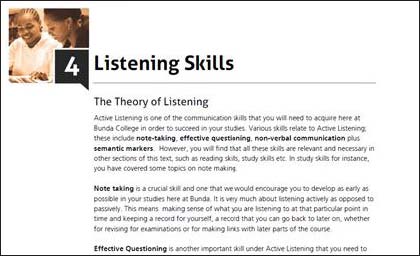
Open Schooling Initiatives
Open Schooling is increasingly recognised as a feasible solution to the lack of qualified teachers and conventional schools in the developing world. With primary school enrolments growing successfully to meet the United Nations Millennium Development Goal of Universal Primary Education, many nations simply cannot accommodate the corresponding increase in potential secondary school students. The Commonwealth of Learning (COL) defines Open Schooling by two elements27:
- The physical separation of the school-level student from the teacher; and
- The use of unconventional teaching methodologies and information and communications technologies (ICT) to bridge the separation and provide the education and training.
OER’s 4 Open Schools, an initiative of COL in collaboration with the William and Flora Hewlett Foundation and Ministries of Education and Open Schools in Botswana, Lesotho, Namibia, Seychelles, Trinidad & Tobago and Zambia is undertaking a range of activities to strengthen the capacity and sustainability of open schools in developing countries. This includes creating practical handbooks, hosting capacity building workshops, commissioning research and providing access to digital resources. In India, the National Institute of Open Schooling (NIOS) (www.nios.ac.in) provides opportunities to interested students by making available a variety of courses/programmes of study through open and distance learning (ODL) modes. These include:
- Open Basic Education (OBE) Programmes for 14+ years age group, adolescents and adults at A, B and C levels that are equivalent to classes III, V, and VIII of the formal school system;
- Secondary Education Courses;
- Senior Secondary Education Courses;
- Vocational Education Courses/Programmes;
- Life Enrichment Programmes.
The Namibian College of Open Learning (NAMCOL- www.namcol.com.na) offers two secondary education programmes, namely the Junior Secondary Education Certificate and the Namibia Senior Secondary Certificate. In addition to this, The Pete Programme is offered to students who intend to pursue further studies in Sciences at institutes of Higher Learning.
The Botswana College of Distance and Open Learning (BOCODOL) was established out of the Distance Education section of the Non-Formal Education Department. BOCODOL helps out-of-school youth and adults to return to learning. It offers them the environment and the opportunities to break barriers to personal development through flexible learning, and offers distance education courses for preparation for the Junior Certificate (JC) and the General Certificate in Secondary Education (GCSE) examinations as well as vocational training and tertiary programmes. In Mexico, communities are scattered across vast distances, with some of these far flung communities having fewer than 100 inhabitants. This has made it an almost impossible task to provide secondary education along conventional lines to these communities. The Telesecundaria (http://telesecundaria.dgme.sep. gob.mx) project (lower secondary school learning with television support) has been instrumental in changing this situation and Mexico’s communications infrastructure is now opening up to different forms of education and learning. Telesecundaria’s mission is28:
Providing the country’s most vulnerable groups secondary education, with a solid foundation in each discipline and ethical principles of social solidarity, allowing them to develop their skills and abilities so that their graduates are able to perform successfully in middle school, as well as responsibly exploit local resources to improve their quality of life through educational activities, materials, computer equipment, use of new technologies of information and communication technologies (ICT) and teaching methods tailored to their specific needs. At the same time providing training and resources for teachers to ensure optimum performance.
OCW OER Search
Finally, there are various search facilities, allowing users to search for relevant HE OER. For example, the Commonwealth of Learning (COL), www.col.org/OER, provides a Google Custom search, which will initially return all OCW and OER results from the higher-education institutions and OER repositories that have been selected. Once on the results page, users can refine their search further by selecting only OCWs or only OER or only OCWs from certain regions.
Another example of a search facility is Folksemantic: www.folksemantic.com. This facility allows users to browse and search over 110,000 OER (although this is not specific to HE resources). The system provides access to, among others, Johns Hopkins, MERLOT and MIT-OCW resources. The developers have also made the code available for others to use.
Likewise, DiscoverEd (http://discovered.creativecommons.org/search) is an experimental project from Creative Commons, particularly interested in improving search and discovery capabilities for OER. It is a prototype that aims to explore how structured data may be used to enhance the search experience, and provides a scalable search and discovery for educational resources on the web. It works like a search engine where users type keywords to find information. The result set reveals metadata for a resource, including subject information and the licence. The results come from other repositories such as OER Commons, Connexions and the Open Courseware Consortium (OCWC). Interested parties are allowed to incorporate DiscoverEd on their own sites.
Conclusion
The above is just a small sample of emerging OER initiatives in the higher education space. They illustrate that there is a burgeoning interest in OER, as well as a fast-emerging web infrastructure to support further growth, sharing and discovery of OER online. Institutional participants include mainstream, highly respected higher education institutions from around the world.
While several of the initiatives outlined above were initiated with donor funding, there is growing evidence that their activities are being integrated into mainstream institutional budgets and that diversification of income streams is taking place rapidly. Most importantly, the above snapshot of examples demonstrates clearly that OER can no longer be considered a peripheral ‘movement’ – it is something with which all higher education planners and policy makers need to engage
______________________
Footnotes
21 www.ocwconsortium.org/about-us/about-us.html
22 See www.ocwconsortium.org/members/consortium-members.html for a full list of members
23 Patrick McAndrew: Motivations for OpenLearn: the Open University’s Open Content Initiativehttp://kn.open.ac.uk/public/getfile.cfm?documentfileid=10026
24 http://www.col.org/SiteCollectionDocuments/WikiEducator%20brochure_PrintCropped.pdf
26 The textbook can be retrieved at: www.oerafrica.org/foundation/FoundationOERHome/ BundaCollegeofAgriculture/tabid/878/Default.aspx

